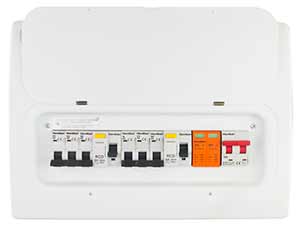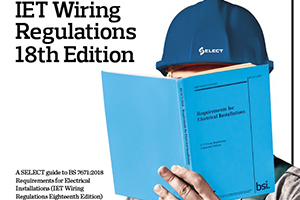Hamilton adds Surge Protection Devices to its circuit protection range

Hamilton Litestat has expanded its circuit protection range in accordance with ‘The 18thEdition’ to include two new Surge Protection Devices (SPDs), providing safeguarding against transients that could prove harmful to connected equipment. Transients originate from lightning or the switching of transformers and motors, and can cause serious injury and potentially loss of life, as well as destroy electronic components or cause premature ageing of equipment. SPDs are therefore recommended to prevent such damage. A provider of circuit protection products – including its sleek and stylish Contour and Convex consumer units – Hamilton now offers two versions of its ‘Type 2’ SPD: a 1-pole device and 2-pole device. The solutions fit snuggly inside the Hamilton consumer units and are recommended to protect against the spread of over-voltages to vulnerable and expensive equipment, such as laptops, PCs, washing machines, alarms and televisions. “Hamilton’s circuit protection offering is proving very popular, particularly its attractively designed consumer units, and we’re pleased to expand and increase our offering to include surge protection devices,” said Gavin Williams, Hamilton’s Head of Marketing. “The 18thEdition of the IET Wiring Regulations that was introduced in July 2018 requires protection against transient over-voltages except in single dwelling units to help protect against serious injury as well as mitigate damage to connected equipment and devices. Hamilton’s new SPDs are thoroughly tested and compliant to protect life and equipment.” Hamilton’s team can offer support and advice on the most appropriate solution for your project. For more information and to contact Hamilton, click here.
SELECT provides industry guidance on the newly launched 18th Edition of the IET Wiring Regulations

SELECT, the campaigning body for the electro-technical trade in Scotland, has been updating its members on key points from the newly launched 18th Edition of the IET Wiring Regulations. SELECT’s Technical Standards Adviser, Bob Cairney, prepared the guide which is available in an on-line format to assist members to understand the changes contained in these important regulations. The guide will also feature in the next issue of SELECT’s CableTalk magazine. Bob said: “BS: 7671:2018 (The 18th Edition of the IET Wiring Regulations) contains a number of significant changes which reflect industry best practice. We have recently been out on the road to highlight the changes during our recent very successful Scotland-wide Toolbox Talks. These were held a few weeks ago and the presentations were well received by the members who attended”. A central theme of the regulations concerns improvements to the level of safety provided in new electrical installations and in particular with regard to fire safety. The 18th Edition introduces new devices called arc fault detection devices (AFDD) and these, where installed can provide an additional level of electrical safety from faults which other protective devices cannot detect specifically arcing faults. These are expected to be widely adopted by the industry. There is also new guidance on types of RCD and arrangement of devices to achieve selectivity between protective devices. Also of interest is informative guidance on energy efficiency. Darrell Mathews, Managing Director of SELECT, said: “These regulations incorporate the latest in technological developments across our sector and, while they do not come into force until 1 January 2019, we want SELECT members, as ever, to be in pole position.” NOTES TO EDITORS SELECT, Scotland’s largest trade association, has over 1250 member companies who collective turnover is around £1 billion and provide employment for 15,000 people. Its members are responsible for over 90 per cent of electrical work carried out in Scotland. Bob Cairney, SELECT’s Technical Standards Adviser, has 40 years’ experience in the electrical industry. For more information about the IET Wiring Regulations please click here
Over a quarter of British adults never look out for fire safety routes or fire exits

The latest research from power management company Eaton reveals that a lack of fire prevention technology and safety awareness, combined with the assumption that appropriate fire safeguards are in place, may be putting the British public at risk. Fire fallacy – adequate fire prevention is not a given The survey of 2,000 UK-based respondents revealed that many British adults take fire safety for granted. More than half (54%) of respondents confirmed that they never feel concerned that property – ranging from homes to offices and public spaces like hospitals – is not adequately protected against fires triggered by electrical faults. The reality is that electrically ignited fires are common in the UK. In fact, the UK’s leading charity on electrical safety, Electrical Safety First, reports that over half of accidental fires in British homes are caused by electricity. This widespread complacency on fire safety was further reflected in British attitudes to fire exit strategies. More than one in four (27%) never try to spot fire safety routes and fire exits when in public buildings like shopping centres, stadia or hotels. A further 40% confirmed that they only look out for fire safety routes or fire exits sometimes or rarely – reflecting a supposition that they will be able to exit a building easily and quickly in the event of an emergency. Lack of awareness The poll revealed that almost one quarter (24%) of British adults “have no clue” what electrical issues can cause a fire to start. While 61% believe that they do know what electrical issues can spark a fire, the reality is that many consumer campaigns have only raised awareness around visible issues such as overloading sockets – yet invisible threats such as arc faults are not understood, and often go unnoticed. This lack of information is worrying given that current UK regulation remains below the level required to maximise protection against electrically-ignited fires. One improvement – the 18th Edition to the IET Wiring Regulations – will be published in July, including recommendations for the use of arc fault detection devices (AFDD) for the first time. The technology will be recommended for use in higher risk buildings, but the regulation stops short of any specific requirements, unlike countries such as Germany and the US where AFDD use can be mandated. Prevention vs. cure New technologies available today provide a further opportunity to prevent rather than just contain fires caused by electrical faults. The British public widely supports a greater focus on fire prevention, with more than half (59%) of the survey respondents confirming that building owners should place more emphasis on fire prevention rather than fire containment. This appetite to implement new fire safety technologies is also reflected in fire evacuation strategies. British consumers are accustomed to “normal” fire escape apparatus, such as highly visible and illuminated exit signs, to escape a building in the event of an emergency but they recognise the benefits of new technologies to improve this process. One third (33%) see the advantages of a voice system which can alert and guide people out of a building, while almost one quarter (24%) would welcome exit signs that can clearly show which escape routes are clear or blocked to guide them out to safety more efficiently. Marc Gaunt, segment lead, commercial buildings, Eaton, commented: “In addition to an increasingly urbanised environment, building owners and managers must consider the rising diversity of safety threats. Evacuation strategies need to be able to adapt to differing circumstances based on the wide range of potential risks today – from fires and natural disasters to acts of terrorism. Faced with this new landscape, steps must be taken to re-evaluate the measures in place to protect both people and property as well as ensure business continuity.” “Building evacuation can prove challenging, particularly if visitors are not familiar with the layout and exit procedures. Large, densely-populated, high-risk or complex premises, such as shopping centres or stadia, can be an even more complicated challenge. New, adaptable technologies exist to help avoid congestion, delays or even people being guided towards unsafe places in the building when trying to evacuate the premises. As one example, adaptive signage enables building owners to direct people outside in the safest way, even when the location or nature of the threat changes. Building owners and facilities managers must undertake their due diligence to ensure the British public’s trust in them is not misplaced.” Methodology Eaton conducted an online survey of 2,000 adults aged 18 and over in the UK through Google. This survey took place between 2nd – 4th May 2018. For more information about Eaton please click here
IET and BSI publish the 18th Edition IET Wiring Regulations

The 18th Edition of the IET Wiring Regulations has published. The essential publication for all professionals working in the electrical industry forms the national standard to which all new and amended electrical installations in the UK are to comply. The IET urges all electrical professionals to ensure they are familiar with the changes before the new requirements come into effect from January 2019. Significant changes include: recommendations for Arc Fault Detection Devices (AFDDs) in AC final circuits, requirements for devices for protection against overvoltage, a change to the requirement for the methods of supporting wiring systems within buildings against their premature collapse in the event of a fire and a new Appendix focusing on energy efficiency. Changes have also been made to the requirements for electric vehicle charging installations with PME supplies (the most common form of earthing in new installations) as well as new guidance for the design and erection of electrical installations that have local production and storage of energy for optimising efficiency. The changes to BS 7671 come from to the revision of international and European standards, of which the UK is obliged to take on the technical intent. JPEL/64 members represent the UK on many of these international committees and the content to be included is discussed in terms of the impact on UK industry, before a new update to BS 7671 is agreed and published. Mark Coles, Head of Technical Regulations at the IET, said: “The IET is the authority for electrical installation in the UK and ensures that JPEL/64, the national Wiring Regulations committee, carefully considers all necessary updates to the Regulations to ensure they best meet the needs of the industry. The 18th Edition of the IET Wiring Regulations contains some significant changes to the way all electrical professionals are required to carry out their work in order to safeguard themselves and the public. With this in mind, it is essential that all electrical professionals ensure that they are up to speed with the new requirements.” BS 7671:2018 and the IET’s popular suite of guidance are available here. To accompany the 18th Edition, the IET is launching online training for the City & Guilds 2382:18 qualification. The only online training to be endorsed by City & Guilds for this qualification, the Full and Update courses both offer flexible learning, in your own time at your own pace. Accessible via an app, the training also includes three, full, practice exams to fully prepare you for the real thing. More information can be found here. To find out more about the new requirements for electrical installations, you can also speak to an expert at the IET on 01438 765599 or email. About the IET Looking for images to accompany your engineering stories? Use the IET’s media image library to highlight the exciting, creative and dynamic world of engineering. Interview opportunities are available with IET spokespeople from a broad range of engineering and technology disciplines including cyber-security, energy, engineering skills, innovation, manufacturing, technology, transport and women in engineering. The IET is one of the world’s largest engineering institutions with over 168,000 members in 150 countries. It is also the most interdisciplinary – to reflect the increasingly diverse nature of engineering in the 21st century. Energy, transport, manufacturing, information and communications, and the built environment: the IET covers them all. The IET publishes more than 30 research and letters journals and over 500 books across engineering disciplines. The IET’s flagship A&I database, Inspec, is globally renowned as a source of essential research in the fields of engineering, physics and computer science. The IET is working to engineer a better world by inspiring, informing and influencing our members, engineers and technicians, and all those who are touched by, or touch, the work of engineers. We want to build the profile of engineering and change outdated perceptions about engineering in order to tackle the skills gap. This includes encouraging more women to become engineers and growing the number of engineering apprentices. For more information, click here Follow the IET on Twitter.




